 |
| MAGNESIA GATE
There are two entrances to the city today. For an easy tour, begin at the Magnesia Gate (Upper Gate) located on the road going to the Virgin Mary House. The photograph at the top is the Upper Gate. Under the trees is the gate the ruins. To the right of the gate are various stores and restaurants. One can also find parking space here. |
|
| Across the road from the gate is a field with remains of what was thought to be the grave of St. Luke, where a church was later built on top of a former temple. Going down the road towards Selcuk is the actual Magnesia Gate itself, the only ancient gate still visible at Ephesus. It was first built in the city walls by Lysimachus in the 3rd century and magnificently restored by Vespasian (69-79). There was once a sacred road leading from the Temple to Artemis around Mt. Panayir to this gate. Damianus built this colonnaded road in the 2nd century. |
|
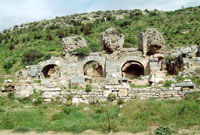 |
|
EAST GYMNASIUM
The remains to the north of the Magnesia Gate belong to a large gymnasium. The road leading in front of is was designed and built by philosopher Damianus in the 2nd century. The structure included baths, a palaestra (sports field) open court area, classrooms and imperial salon. |
|
| VARIUS BATHS
These baths were excavated off and on between 1929 and 1979. There is still more to uncover. It was built on a flat place at the foot of Mt. Panayir. For this reason it made use of the natural rock face in the mountain. This bath is typical of Roman baths, which include a cold room (frigidarium), a hot room (caldarium), and a tepid room (tepidarium) with wide-open spaces beside it. |
|
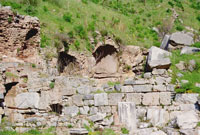 |
|
| The walls were made of large blocks with a vaulted brick roof. Latrines were on the south side. |
|
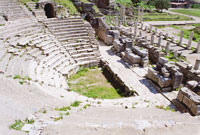 |
|
BOULETERION (Odeon)
To the north of the agora is the small theater, the Odeion. According to an inscription found in the digs the notable Ephesian family of Publius Vedius Antonius and his wife Flavia Papiana built the Odeion for a Council Chamber in 150 AD. In this structure built at the foot of Mt. Panayir, there are the three areas usually seen in theaters: the cavea (seats), orchestra, and scene. |
|
| The cavea and orchestra are semi-circular in shape and the scene was most probably two-story. Since there is no drain for rainwater in the center, it is assumed that the odeion was closed in. It could seat 1400 people. It was used for both concerts and council meetings. |
|
| BASILICA
In front of the Odeon was a commercial center, called the "Basilica". It was next to the State Agora to expedite business affairs. The building was erected with three naves at the time of Augustus in the 1st century AD. Judging by the holes bored into it, there was a single-nave gallery here in the Hellenistic Period. |
|
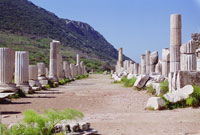 |
|
| A number of the columns have been restored and set in place. In Byzantine times there was a large open court (stoa) to the side of the Basilica that was decorated with numerous statues. The court had three doors, the largest opening from the basilica. Giant statutes of Augustus and his wife, Livia that were here are now in the Ephesus Museum. The basilica was 165 m. in length and had typical bull-headed columns in the Ionion style. |
|
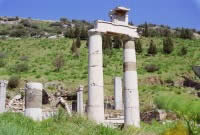 |
|
PRYTANEION (The Town Hall)
The greatest position that any citizen in the, male or female, city could occupy was that of "Prytan." This person maintained the eternal flame from the city fireplace that was the symbol of the city and the place from which everyone lit their fireplaces at home. The lucky person performed his duty in the name of the goddess Hespian. |
|
| All expenses were met by the Prytan himself. The operating of the Temple to Artemis was outside this temple system. The Prytaneion was a large, covered room with a large portcullis. At the front were eight large Doric columns which completed the temple appearance. The eternal flame of Hestia burned for centuries. The figure of Artemis that is in the Ephesus Museum was found here intact. Among the pieces found scattered around the site was a list of the "Union of Curates". At first only six, the number of curates increased to nine, these were a class of priests at the Temple to Artemis. The Praytaneion was first built in the 3rd century BC and brought to its final state at the time of Augustos. There were two-figured pedestals on either side of the road leading to the Square of Domitian. |
|
| STATE AGORA (Upper Agora)
This agora measures 160 by 56m and was first established in the first century AD. The state monitored the religious and political meetings held here, and was considered a semi-sacred place. As with many agoras there was a square temple in the center. The temple was decorated at the top by figures of Odysseus' Polyphemos and his adventures. |
|
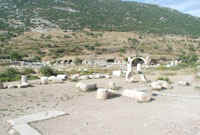 |
|
| Later the Pollio fountain was located on the western edge of the agora. The agora was brought to its latest configuration in the time of Theodosius (379-395 AD). There were two porches on the north and east sides. |
|
 |
|
POLLIO FOUNTAIN
The fountain is on the east of Domitian Square, on the western edge of the agora. This is a splendid structure with a small pool and a large arch supporting a triangular capital. The water came from the agora through a semicircular apsidal in the wall. In the pool on a pedestal was a Polyphemos statue group, which is not on display in the Ephesus Museum. |
|
| The statues were originally on the Temple to Isis, which later fell into ruin. The statues were then transferred to the fountain. The theme of the statues is the adventures of Polyphemus with the son of Poseidon after he moved to the Aegean following the Trojan Wars. According to an inscription on the fountain, it was built in 97 AD by C. Sextilius Pollio. |
|
| DOMITIAN FOUNTAIN
During its history Ephesus was four times the Neochoros, that is, the place where the emperor's temple was situated. In those times to have the emperor's temple in the city was quite an honor. Ephesus won this right for the first time under Domitian (81-96 AD). In the southern part of Domitian's Square was a flat terrace 50 by 100m where the temple stood. |
|
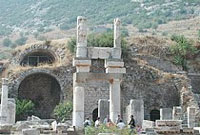 |
|
| Nothing much is left of it now but the size of the podium is known to have been 24 by 24m with eight rows of crepis. The temple was in prostyle formation. There were eight columns on the short sides and three on the long. There was also a platform 9 by 17m with four columns in front. The altar was 10m in front of the platform in a "U" shape with steps leading up to it. Part of the beautiful workmanship can be seen in the Ephesus Museum. In order to pay their debt of gratitude for locating the temple in their city, the Ephesians erected a statue of Domitian five meters tall in front of the temple. It was seven meters together with its pedestal. Parts of the statue are in the museum. |
|
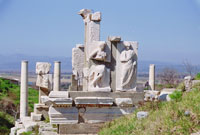 |
|
MEMMIUS MONUMENT
The Memmius Monument was built in the shape of a four-sided victory crown and was located on the north side of Domitian Square. The pedestal is a bulging local stone and the upper part is of marble. There were four steps leading up t it on all sides. There was an arch on every side and semicircular naves with block figures above |
|
|
them. At the base of each arch was hand carved stone work. Most of the figures were lost. The figures still visible in the monument are of Memmius and his father, Gaius and his grandfather the dictator Sculla. The monument was built in the first century. |
|
| HERACLES GATE
This is at the beginning of Curates Avenue to the west of the Memmius Monument. It had two floors. Below there was an arched entrance and six columns above. This later structure was made to resemble motifs of the Gate of Heracles. It was thought to have been built in the 4th or 5th centuries. |
|
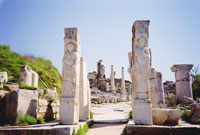 |
|
| Some pieces of the entrance remain. The Gate of Heracles was built in the 2nd century and later moved to this location. |
|
|
next
 |
|
|
 |
|
|
|